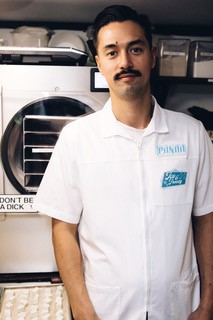Attributing Technique
Jim Meehan explores the challenge of claiming ownership of techniques in the industry with thoughts from Toby Maloney, Jeffrey Morgenthaler and Iain McPherson.
27 January 2025 · 8 min read


It’s common courtesy for cocktail recipes to be attributed to their creators on cocktail menus when the author is known, but what about using another bar or mixologist’s signature technique? New drink mixing methods are rarely perceptible enough to their imbibers to warrant recognition; but as popular and dramatic public-facing techniques like Ago Perrone’s waterfall citrus zest, and innovative behind the curtain processes like Iain McPherson’s switching are adopted across the industry, I wonder whether bar operators should be citing the originators with their techniques too? Toby Maloney, who co-authored The Bartender’s Manifesto, thinks so; noting
“that things should be attributed to the person who pioneered a thing, whether a cocktail, a technique or an idea.”
His perspective comes from decades of bartending experience at the frontier of mixology in New York City, Chicago, Minneapolis and Nashville in the early years of the Cocktail Renaissance in the U.S., when
“the bartending world had a very different way of sharing information before video took over the internet. Zeitgeist crept much more slowly over our culture.”
“In the days before there was a cocktail bar on every corner, and the internet made it super easy to reach across the world to ask questions, I worked in cities where sharing everything was the norm and in cities where everyone kept their information close to the vest,”
Toby told me. From my personal recollection of this time, those years felt like a figurative Cold War (with ice cubes instead of missile technology) arms race (relying on actual arms). In contrast to acrimonious wartime inhibitions,
“the cities that were forthcoming with all the info had better bars, and happier bartenders. Also, happier bar guests,”
Maloney attests. One example of a pioneering technique originating from this time is former Milk & Honey bartender Chad Solomon’s “Dry Shake”, which was quickly adopted (but infrequently attributed) by most cocktail bars
“because it obviously improved the quality of the cocktail and didn’t need specific equipment” according to Maloney.
“So, I would say that adoption of a new technique depends on how easily it improves the cocktail and how easy it is to train and institute.”

Edinburgh’s Iain McPherson also asks if
“the technique has a noticeable impact to the flavor? Secondly, does the technique need expensive equipment? Lastly, is it straight forward to do? If a technique ticks all these boxes, you will generally see it being adopted.”
Before social media platforms aggregated information algorithmically and shared it with users (which helps with the attribution process) according to their interests; bartenders relied on mixing expertise gleaned from fellow bartenders, trade organizations, authors, journalists and bloggers- some of whom happened to be bartenders too. McPherson fondly recalls reading about Portland, Oregon based bartender and author of The Bar Book Jeffrey Morgenthaler coming up with barrel aged cocktails on his blog;

“as a young bartender I was so mind-blown.”
Jeffrey told me
“I’ve long shared various techniques on my website that I’ve worked out on my own over the years - the blog is twenty years old this year so there’s quite a library in there, from carbonation tips to barrel aging cocktails, lots of house made ingredients etc.”
This is where a new generation of bartenders (and his aged contemporaries) can also find Jeff’s batch calculator and conversion sheets and learn more about newfound technique preferences, such as using a cheese knife instead of a y-peeler to cut citrus twists. As the proprietor (Jeffrey) of classic and original recipes along with techniques emulated all over the world, I asked him what he thought about the prospect some bartenders have raised of trademarking their ideas. He told me that

“as someone who has been freely sharing everything he’s learned on the internet (and in books and articles), I’m very opposed to any bartender trademarking recipes and techniques.”
McPherson concurred, noting
“I think the trademarking thing is too grey an area. I’m getting Painkiller flashbacks (a handful of spirit companies have trademarked their recipes and gone to court to uphold them) thinking about this.”
While all three bartenders agreed that innovative techniques should be attributed and shared, none of them preferred a solution for how authorship should be disclosed. When I suggested that techniques could be attributed on menus or verbally in service, Morgenthaler pumped the breaks, declaring
“that’s way too much information. I don’t think a cocktail menu needs to read like a bibliography.”
Maloney echoed Morgenthaler, suggesting that
“the people who really want to know this information will ask about it. Most folks just want a cocktail, fast.”
McPherson wouldn’t even commit to attributing his own techniques on a menu.
“I’m not precious though, if people don’t want to credit me with a technique, I’m ok. I mean do we accredit who invented Sous vide?”
Instead, he believes the information needs to be communicated through staff training.
“The staff need to know how the technique works, what its advantages are, and who created it. In 10 second and 30 second elevator pitch, plus long worded explanation if someone is genuinely wanting to geek out.”
When I asked each of them about their metrics of evaluation for testing and adopting new techniques, Toby told me that
“there was a time where we needed to study the past so we didn’t reinvent the wheel; but these days, I’m more interested in ingenuity and integrity than authenticity. (But then again, I don’t run a program at a hundred-year-old bar.)”
Morgenthaler echoes Maloney, declaring
“I refuse to be one of those old bartenders who does something because that’s how we’ve always done it.”
McPherson says he still uses techniques he created years ago
“but how we approach them now, vs then is completely different. Just because we come up with a technique, doesn’t mean we know everything about it, we believe there is always room to improve and learn”.
Building upon the importance of curiosity and functionality in his kaizen approach to cocktail technique, McPherson recommends approaching innovation and refinement with respectful discretion where it’s warranted.
“There is a time and a place for a technique, no matter how “improved” a modern technique may be. Can we imagine a milkshake machine replacing throwing at Boadas? There is a charm to old techniques, looking forward is good, but don’t disregard tried and tested techniques, just because they aren’t new and cool.”









